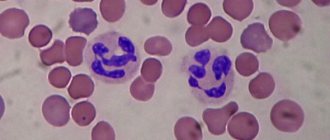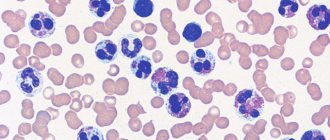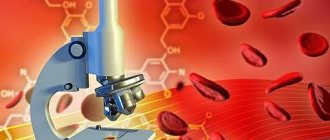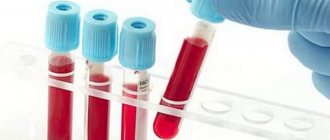67
Author of the article: Marina Dmitrievna
2017.08.20
88 561
Blood analysis
When the doctor says that the blood test is unfavorable and there are problems, many people panic. This is especially noticeable when studies talk about a child’s illness.
When white blood cells are higher or lower than normal, this means the following:
- neutrophils are decreased;
- lymphocytes are higher than normal;
- simultaneously increased level of lymphocytes and decreased level of neutrophils.
The reasons are different, and the attending physician has to identify them and help the patient get rid of them. Lymphocytes in the blood will help find the sources of problems.
Immune system cells
Neutrophils and lymphocytes are among the white cells. Among ordinary people they are known as leukocytes. A certain type of cell in this broad group has a specific function aimed at protecting against disease. When performing a blood test, the doctor takes into account the relative content of each type of white blood cell, not just the level of white cells.
What are leukocytes? These include colorless blood cells that form a “dam”, a shield that will not allow infection to pass through. These cells contain substances with which the body gets rid of pathogenic organisms. They are able to neutralize the decay products of harmful microorganisms.
What functions do lymphocytes perform?
Lymphocytes are specific cells that are formed in the bone marrow. They are a defense mechanism against infections and are therefore considered the main components of the immune system.
Neutrophils are the most numerous class of immune cells (their part ranges from 45 to 72%). The function of neutrophil cells is to destroy bacteria. If foreign bodies enter the body, this type of white blood cell immediately rushes to the part of the body from where they came. Ultimately, infections are absorbed by neutrophil cells and digested.
Leukopenia and leukocytosis
A decrease in total leukocytes (leukopenia), including neutrophils and lymphocytes, is observed in systemic lupus erythematosus. This autoimmune disease is diagnosed at any age and is manifested by enlarged lymph nodes, anemia, and a specific rash on the back of the nose.
A decrease in lymphocytes in children is observed with a lack of protein food, anemia, and autoimmune diseases.
In immunodeficiency states, a clinical blood test reveals both low lymphocytes and low neutrophils. A similar phenomenon may be associated with a congenital pathology of hematopoiesis in the bone marrow.
Increased levels of leukocytes (leukocytosis), lymphocytes, neutrophils with lymphadenitis. The main symptom of lymphadenitis is inflammation of one or more lymph nodes at the same time. Infectious agents of various natures, including viruses and bacteria, can cause inflammation. With lymphadenitis, the inflamed node swells, the skin over it becomes red, hot, and when pressure is applied to the node, severe pain occurs.
Other leukocyte cells and their significance
In order for the picture to be complete, it will be necessary to consider blood components that are less significant for the body (but not for the immune system). These groups of leukocytes include the following:
- Monocytes. Large elements related to phagocytes. Diseases develop depending on the number of monocytic type cells. An increase in the percentage of monocytes indicates relative monocytosis. If monocytes are increased in number, then doctors diagnose absolute monocytosis. Sometimes other blood cells can change their numbers along with monocytes. Lymphocytes and monocytes are rarely elevated at the same time in a child. The main cause of the phenomenon is infections.
- Basophils. They are classified as scouts. Basophils contain histamine, serotonin and other highly active components. Upon contact with allergens, they burst and their contents affect the allergen.
- Eosinophil cells. Eosinophils are a population of leukocytes that perform a marker function. Disease cells are identified. The norm of eosinophils for humans is from 1 to 5%. When lymphocytes and eosinophils are elevated, this indicates the body is allergic. If eosinophils are elevated in a child, an analysis is performed for helminthic infestations, rhinitis, scarlet fever and chickenpox.
All cells associated with leukocytes should be normal. If levels are low or high, therapy should be carried out immediately to stabilize them.
The role and indicators of the number of neutrophils in the blood
Neutrophil balance is an important indicator for the body. The number of these cells is normal if their percentage ranges from 45 to 72%. A lower value is typical for children under one year old, and the older the child, the more leukocytes of this type are in the body.
Note! The percentage of cells may increase, but their number remains the same with age.
What happens if the activity of neutrophils increases or decreases?
If neutrophils are increased, then this is neutrophilia. Most often, the disease is caused by the development of inflammation. By examining the number of neutrophil granulocytes, conclusions are drawn about the scale of inflammatory processes and the resistance of the immune system. If children are 1 year old, then there is no need to worry about neutrophilia when their percentage of corpuscles is about 30%.
If a child’s neutrophils are low and lymphocytes are high, then it makes sense to consider not only viral infections. The reasons why neutrophils are reduced and lymphocytes are increased in adults or children are malignant tumors, radiation and medications. If, when neutrophils decrease, other cells increase, then the immune system fights the disease.
A decrease in neutrophils is associated with the following factors:
- infection of the body with viral infections;
- advanced inflammation;
- use of radiation therapy;
- exposure to radiation;
- development of agranulocytosis (signals that there are no granulocytes and lymphocytes in the blood).
Low neutrophils in the blood can be caused by medications, or rather, side effects from them.
Therefore, in the deciphering process, it is worth considering the number of neutrophils, since their increase or decrease indicates violations. If you pay attention to these changes in time, you can avoid some of the negative consequences caused by inflammatory processes.
The Neutrophil Challenge
Neutrophils are the most common type of white blood cell. They have a short lifespan (from 5 to 90 hours) and have the ability to penetrate body tissues better than other white blood cells. The reason for this is the activity of these cells and their small size.
Neutrophils instantly respond to signals of inflammation in the body and are sent through the blood vessels to its source. If the infection is too severe, they die and form pus, attracting other types of white blood cells. Neutrophils also secrete various antibacterial substances and enzymes.
This type of immune system cells is usually divided into band and segmented cells. Segmented neutrophils have the main function in the immune system, since they have a greater ability than band neutrophils for phagocytosis, that is, to absorb and dissolve pathogenic microorganisms and particles.
In a newborn child, the number of band neutrophils ranges from 5 to 12% of the total number of leukocytes.
Then their number decreases and fluctuates between 1 and 5%. Segmented neutrophils are of greater importance in the functioning of the child’s immune system. In children from one to six years of age, the proportion of segmented cells ranges from 50 to 70%, then decreases and in an adult it remains in the range of 40-60%.
Functions and norm of lymphocytes
Lymphocytes are responsible for the adaptive function of the immune system. This means that the ability to resist infection adapts to the environment as we age.
These particles belong to one of the following categories:
- T-lymphocytes – contribute to the formation of thymus and thymus cells; play an auxiliary role in the process of synthesis of signal substances;
- B-lymphocytes - take part in the production of bone marrow cells, which allows us to call them the “parents” of the body’s immune function; with their help, antibodies are produced.
- natural “killers” – secrete cytotoxins that help cope with pathological cells.
Note! Lymphocytes are low when their content in the blood of adults and children under 6 years of age is less than 25 and 45%, respectively.
High lymphocytes make it clear that the body has the following ailments:
- viruses;
- tuberculosis;
- lymphocytic leukemia;
- hyperthyroidism – increased production of thyroid hormones;
- lymphosarcoma.
Depending on the increased or decreased portion of the corpuscles, the state of the body and the presence of diseases of viral etiology are judged. Elevated lymphocytes will indicate inflammation. Therefore, it is imperative to visit a doctor after a disappointing analysis.
It is worth noting the possibility of human vaccination, which opens up thanks to lymphocytes. This is possible due to the fact that the bodies contain memory cells. They store antigens in a coded state.
Basis for increasing lymphocytes
An increase in lymphocytes is called lymphocytosis. It can also be physiological or pathological. In the first case, the basis for the increase should be considered hard physical work and menstruation in women.
Pathological lymphocytosis is observed in all infections, both in childhood (chickenpox, chicken pox, whooping cough) and in adults (influenza, ARVI). Other reasons for increased lymphocytes in the blood include:
- Infectious mononucleosis.
- Cytomegalovirus infection.
- Transition from acute to chronic disease.
- The stage of inflammation subsiding.
- Bacterial infections.
- Autoimmune diseases.
- Acute immediate allergic reaction (anaphylaxis).
- Malignant and benign tumors.
Severe lymphocytosis is characteristic of chronic lymphocytic leukemia and Waldenström macroglobulinemia.
Lymphocytosis is usually divided into relative and absolute.
Relative lymphocytosis occurs when lymphocytes remain normal, but displace neutrophils and their percentage is reduced to the minimum possible. This happens with diseases of the joints of a rheumatic nature, with increased levels of thyroid hormones or with an increase in the size of the spleen (splenomegaly).
Absolute lymphocytosis is an increase in the number of lymphocytes at other norms. This occurs with toxoplasmosis, viral pneumonia, tuberculosis, syphilis, brucellosis and diphtheria.
Analysis and its features
Lymphocytes and neutrophils can tell a lot about a patient's condition. Therefore, it is recommended to take a general blood test once a year. Deciphering will allow you to detect hidden pathological processes caused by low levels of leukocytes or their high proportion in the blood.
Low corpuscle count is determined by blood test
An increased or decreased proportion of corpuscles indicates disease.
- Acute viral infection. It is indicated by an increase in the number of leukocytes, low neutrophils and an increased content of lymphocytes.
- Chronic viral infection. Here the analysis is ambiguous. Therefore, the following picture is observed:
- the quantitative content of leukocytes is optimal or reduced;
- increased lymphocytes or their presence at the upper limit of the normal value;
- the low content of neutrophils is insignificant or they are close to the lower limit of normal.
- Acute bacterial infection. There is a reduced level of lymphocytes. The total number of leukocytes increases, the level of neutrophils is high.
- Chronic or local bacterial infection. The same symptoms are noted as in the previous case. But they are closer to normal levels.
Counting the number of white cells will identify many infections. By analyzing the high or low percentage of white blood cells, the doctor will order tests and make a diagnosis. The analysis will help detect rare autoimmune diseases, blood diseases and immune deficiencies. When white blood cells decrease or some of them increase, the quality of chemotherapy is judged.
The process involves taking fluid from a vein and finger. Most often, material collection for diagnostics is carried out without complications. But sometimes it happens that the doctor cannot find the vein or the needle gets stuck in the muscle.
Causes and symptoms of increased neutrophils
Neutrophils occupy from 47 to 72% of the total mass of leukocytes. This seems like a lot, but in fact it is the norm. Neutrophils, like lymphocytes, protect the human body from foreign agents.
When a neutrophil encounters a microorganism on its way, it immediately begins to eat it. The further fate of this cell is death.
Situations arise when neutrophils become much more than normal:
- At birth. If the birth went well, then in the first hours of his life the baby’s neutrophil levels will exceed a certain norm. This situation is considered standard.
- In adults, this means the presence of inflammation in the body. This includes even the most harmless cases, such as getting a splinter or developing caries. But we shouldn’t forget about serious problems, for example, appendicitis.
A high level of neutrophils may also indicate the presence of purulent abscesses (furunculosis, inflammation of the brain and other organs).
Some people don’t even suspect such terrible diseases, since the symptoms of an increase in neutrophils are almost imperceptible. A timely blood test can prevent tragic consequences.
Sepsis is also considered one of the reasons for the increase in neutrophils. Blood cells are formed at a frantic pace, but still fail to cope with the task, which is to eliminate foreign agents. Sepsis can develop as a result of pneumonia.
Every infectious disease should be monitored by a specialist. A professional approach to treatment can protect the patient from complications that are quite difficult to overcome.
Data decryption
What does the high content of certain cells or their reduced number indicate? If some cells increase, accompanied by a decrease in others, then this indicates one thing - there is inflammation, which the body is fighting.
If lymphocytes are elevated, the following diseases should be diagnosed:
- tuberculosis;
- thyroid disorders;
- lymphocytic leukemia;
- illnesses of viral etiology (this is evidenced by decreased cells).
Medicines can cause a reduced number of lymphocytes. Radiation therapy for cancer can affect the indicators. And if the test results exceed the norm or the number of cells is reduced, then you should think about the reasons. Only the attending physician will tell you why lymphocytes are increased in an adult and neutrophils are decreased.
A high proportion of leukocytes will indicate problems with immunity
It is worth considering other decryption options that are encountered. If segmented neutrophils are reduced in an adult, and lymphocytes are increased, this indicates that the disease has passed. There will soon be no trace of the increase or decrease - the leukocytes will return to normal.
Important! Segmented cells are called mature cells, i.e. those that interacted with infections.
Application of ionizing radiation also results in low or high white blood cells. Therefore, this should not be ruled out. There may be many or few leukocytes in the case of immune agranulocytosis. This disease represents the death of neutrophils even before formation.
Age-related features of the leukocyte formula
In childhood, during the formation of immunity, the normal indicator of the number of neutrophils and lymphocytes differs from the indicators of an adult.
For neutrophils, things are like this:
- First year of life: segmented - from 15 to 45%, band - from 0.5 to 4.5%.
- Up to 6 years of age: mature – 25-60%, young – up to 4.5%.
- After 6 years: mature – 30-60%, young – up to 6%.
An increased level of immature neutrophils and a decreased number of mature neutrophils indicate the occurrence of pathological processes caused by bacterial flora.
The level of lymphocytes in children is relatively high, since during this period the body’s protective functions malfunction, so up to 6 years the norm is 26-60%. Afterwards, the immune system begins to work normally, and the indicators drop to the usual level for an adult of 22-50%.
For an adult, this is the normal leukocyte formula:
- Lymphocytes – 22-50%.
- Bands - up to 6%.
- Segmented - 30-60%.
You also need to take into account that these indicators can change during the day and depend not only on the physical condition of a person, but also on his psychological comfort.
Under stress, prolonged nervous tension, and chronic fatigue syndrome, the number of lymphocytes drops. Consequently, the body's resistance to various viral infections decreases.
In women, the blood formula may depend on the menstrual cycle, so during menstruation the number of lymphocytes will be higher than normal. But the indicators stabilize very quickly and do not indicate pathology, since they are part of the physiological process.
Any change in the leukocyte ratio indicates the presence of one or another health problem. But it is possible to say what kind of pathology is present after conducting a series of clinical studies.
It is a general blood test with a detailed formula that will tell a specialist that there is a problem. In addition, the percentage of white blood cells will lead to a possible cause of the disease. This means a diagnosis will be made and adequate treatment will be prescribed.
Their normal level in an adult is 25%-40% of the total number of leukocytes. In children, the content changes as the body matures and grows.
In newborns, in the very first days of life, their number is no greater than that of neutrophils. The percentage concentration will be approximately 25%. And after a week it becomes equal and reaches about 42%.
At six years, the cell concentration already reaches 45%-65%. This means that in the general leukocyte formula their number becomes predominant. In the blood of a six-year-old child, it is again equal to neutrophils, but as they grow older, it will gradually decrease.
Diagnostic technologies
Before assessing the overall picture and how to lower or increase the white blood cell count, the doctor will need to study many factors. These include:
- methods of therapy;
- symptoms;
- anamnesis;
- gender, age and poor heredity of the patient.
The white blood cell count may be elevated or vice versa if the patient is taking medications. Therefore, in order to avoid a falsely high cell count, you should warn your doctor about taking medications. Medications that can “saturate” the body with low levels of corpuscles include:
- antibiotic group drugs;
- antihistamines;
- diuretics;
- steroid hormones for the adrenal glands;
- clozepine and heparin.
The analysis data is affected by relaxants, chemical or radiation therapy. These drugs cause an increased proportion of white cells.











